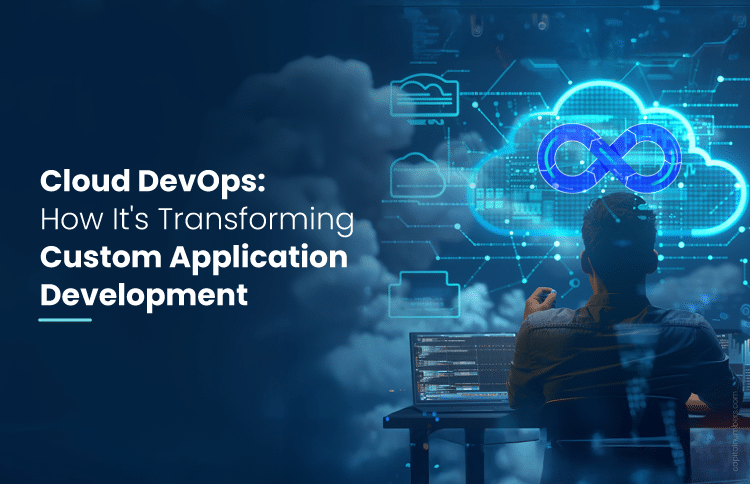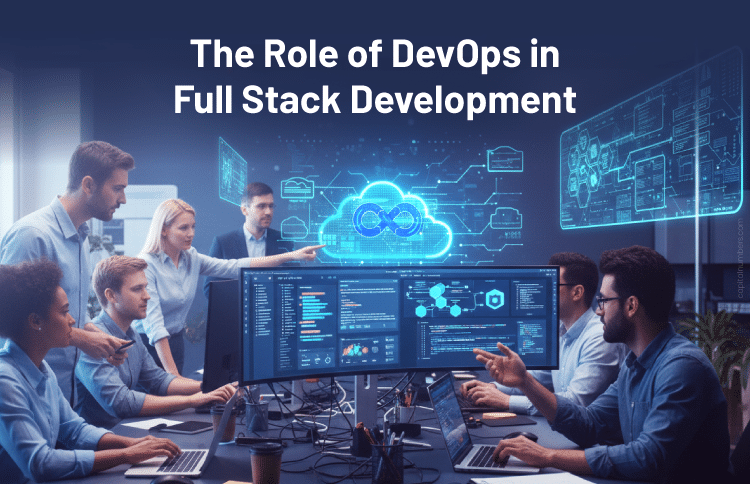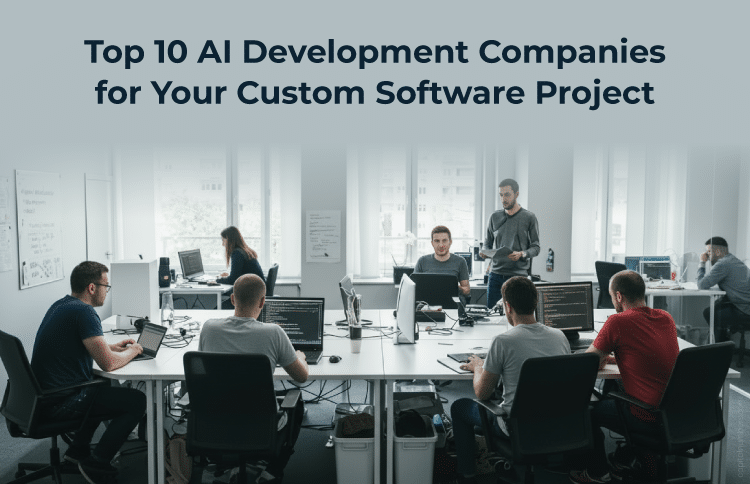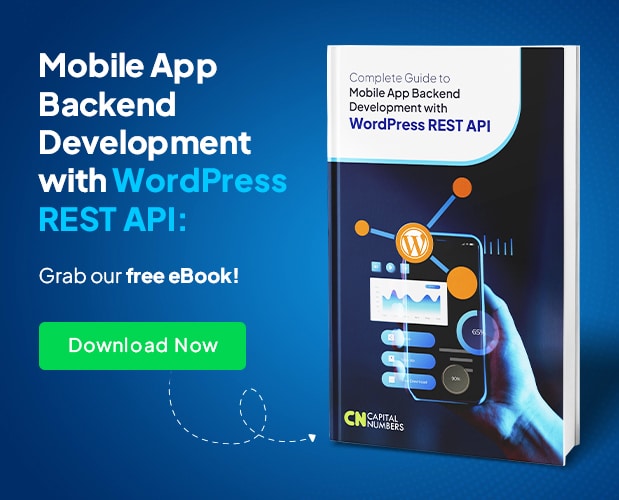Cloud DevOps: How It’s Transforming Custom Application Development
Table of Contents
Is your team still stuck in the past, facing slow, manual releases, fragmented workflows, and high-risk deployments? The era of software development roadblocks is over. The old way of doing things – with fragmented teams, manual processes, and high-risk releases – is no longer a viable path. This has given rise to a powerful new approach.
Cloud DevOps is the revolution that unifies the entire software development lifecycle. By using the power of cloud infrastructure, it transforms a chaotic, manual process into a unified, automated, and continuous flow. In this guide, we will show you how this strategic approach unlocks unprecedented speed, quality, and innovation for your custom applications.
Understanding Cloud DevOps
So, what’s the big idea behind Cloud DevOps? It’s the cultural and technical practice of uniting development and operations teams to automate and streamline the software delivery lifecycle. While traditional DevOps can be implemented on-premise, Cloud DevOps uses cloud-native infrastructure, offering unique advantages such as ephemeral environments, cloud elasticity, and global availability. These features maximize automation and agility, making it possible to adapt dynamically to workloads, scale on demand, and deploy across regions seamlessly. It’s about building cloud-native applications that can automatically scale, self-heal, and adapt to dynamic environments, providing high availability and performance.
Key Pillars of Cloud DevOps
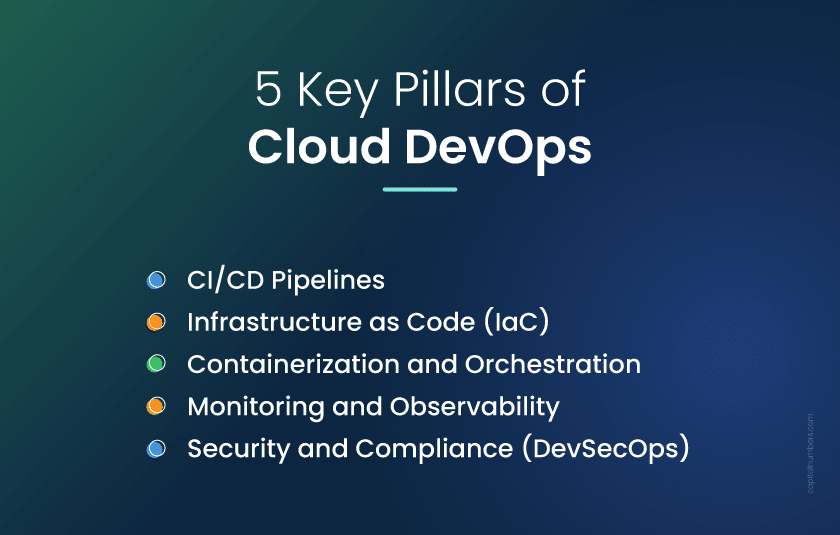
Cloud DevOps forms the backbone of modern software development, transforming the way teams collaborate, build, and deploy applications. A successful Cloud DevOps strategy is grounded in several essential pillars, each playing a crucial role in enhancing efficiency, reliability, and scalability. Here are the ones:
CI/CD Pipelines: The Automation Heartbeat
Continuous Integration (CI) and Continuous Delivery (CD) form the base of automation in Cloud DevOps. CI ensures that code is continuously integrated into a shared repository, where it is automatically built and tested. CD then automates the deployment of validated code to production environments, enabling rapid and reliable releases. With automated testing and validation, developers can confidently deploy changes with minimal risk of breaking the application.
Key Tools:
- Jenkins: A widely-used open-source automation server that orchestrates the build, test, and deployment phases, supporting multi-cloud integrations.
- GitHub Actions: Automates workflows directly from GitHub, allowing you to build, test, and deploy code directly from your repositories.
- GitLab CI: Integrates seamlessly into GitLab repositories, enabling automation and monitoring of CI/CD pipelines, with support for AWS, Azure, and GCP integrations.
- Azure DevOps: A suite of development tools offering CI/CD pipelines, version control, and collaboration features on the Azure cloud.
You May Also Read: GitHub vs GitLab: How to Pick the Best for Your Project
Infrastructure as Code (IaC): Building with Blueprints
Infrastructure as Code allows you to define and manage your cloud infrastructure using code, rather than manual configuration. By using version-controlled configuration files, IaC guarantees consistent and repeatable environments for applications, eliminating the risk of configuration drift. Beyond provisioning, IaC also enables versioning, fully automated pipelines, repeatability, and rollback capabilities, which are critical for disaster recovery and compliance. IaC also accelerates provisioning of cloud-native applications and simplifies migration from on-premise to cloud.
Key Tools:
- Terraform: An open-source IaC tool that enables you to define infrastructure across various cloud providers (AWS, Azure, GCP) using declarative configuration files.
- AWS CloudFormation: An IaC service that allows you to define your AWS infrastructure as code, providing repeatable and consistent environment provisioning.
- Ansible: A configuration management tool that automates cloud infrastructure provisioning and management, ensuring consistency and reducing manual tasks.
Containerization and Orchestration: The Portable Packaging
Containerization simplifies development and deployment by packaging an application and its dependencies into a self-contained unit that can run consistently across different environments. Containers also help with legacy app migration by encapsulating older applications in a portable format. Container orchestration tools automate deployment, scaling, and management across multiple environments.
Key Tools:
- Docker: The most widely used containerization platform, Docker packages applications and their dependencies into containers, ensuring portability and consistency across environments.
- Kubernetes (K8s): A powerful container orchestration tool that automates the deployment, scaling, and management of containerized applications. It provides service discovery, load balancing, and automatic scaling to meet dynamic traffic demands.
- Helm: A package manager for Kubernetes that simplifies the deployment and management of applications by using Helm charts, which define Kubernetes resources in a standard way. While optional, Helm is especially useful in large-scale environments with multiple applications and complex configurations.
Struggling with Kubernetes and Cloud DevOps?
Managing Kubernetes while implementing Cloud DevOps practices across multiple cloud platforms can be complex and time-consuming. Our expert team simplifies this for you, ensuring smooth deployments, efficient scaling, and seamless integration across AWS, Azure, and Google Cloud.
Get in touch with us for Kubernetes consulting and managed services!
Monitoring and Observability: The Application’s EKG
After an application is deployed, maintaining its health is crucial. This pillar focuses on gathering real-time data such as metrics, logs, and traces to gain visibility into the application’s performance and behavior. By continuously monitoring these aspects, teams can detect and resolve issues proactively, ensuring minimal downtime and optimal user experience.
Key Tools:
- Prometheus: An open-source monitoring system designed for cloud-native environments, collecting and storing time-series data about application health and performance.
- Grafana: A visualization tool often used alongside Prometheus to create detailed dashboards and reports on application and infrastructure metrics.
- ELK Stack: Comprising Elasticsearch, Logstash, and Kibana, the ELK stack provides powerful logging, searching, and visualization tools, helping teams track and analyze logs.
- Datadog: A comprehensive monitoring and observability platform that provides end-to-end visibility across infrastructure, applications, and logs, helping teams ensure reliability.
Security and Compliance (DevSecOps): Shifting Left on Security
DevSecOps integrates security practices directly into the DevOps pipeline, shifting security to the left – meaning security is considered from the beginning of the development process, not as an afterthought. With automated security tools, teams continuously scan for vulnerabilities, ensuring applications are secure by design. This proactive approach ensures compliance and protects against threats early, making the application more resilient.
Key Tools:
- Snyk: A security tool that identifies vulnerabilities in application dependencies, container images, and IaC configurations, helping developers secure their code early.
- Aqua Security: A tool that secures containers, Kubernetes, and cloud-native applications by detecting vulnerabilities, enforcing security policies, and ensuring compliance.
- HashiCorp Vault: A tool for managing sensitive data, such as secrets and encryption keys, within the DevOps pipeline, ensuring secure access and compliance with industry standards.
- Additional Security Practices: Implement SAST and DAST for continuous scanning of code and running applications.
You May Also Read: Accelerating Software Delivery: DevOps Best Practices for CTOs
5 Ways Cloud DevOps Transforms Custom Application Development
The technical details of Cloud DevOps are impressive, but what do they mean for a business? Why should you choose it when opting for custom software development services? Cloud DevOps is not just about adopting new tools; it’s about driving performance, efficiency, and innovation across your entire software development and delivery pipeline. Here’s how it transforms custom application development for businesses:
1. Accelerating Time-to-Market
One of the biggest benefits of Cloud DevOps is the speed it brings to development cycles. Automated CI/CD pipelines allow your development team to build, test, and deploy code with minimal manual intervention. As soon as a developer commits changes, the pipeline automatically tests the code, deploys it to staging environments, and pushes it to production once validated.
For example, in an e-commerce company, this means developers can introduce new features, like a flash sale page or a new payment method, within hours instead of weeks, responding quickly to customer needs and market trends.
2. Ensuring Scalability and Flexibility
Cloud-native tools, especially Kubernetes, provide automatic scaling for your applications. When a sudden surge in traffic occurs, such as during a Black Friday sale or following a viral marketing campaign, Kubernetes can automatically scale your application up to meet demand. The best part? It can scale down just as easily when traffic returns to normal, helping you save on cloud resources and reduce costs.
This flexibility ensures that your infrastructure is always optimally configured to handle varying levels of demand, without the need for manual adjustments or overprovisioning. This scalability is one of the key advantages of adopting cloud service models, as you can easily adjust resources based on traffic without upfront investments in physical hardware.
3. Enhancing Reliability and Quality
In Cloud DevOps, automated testing ensures that only the highest quality code reaches production. Unit tests, integration tests, and end-to-end tests are triggered automatically within the CI/CD pipeline, catching bugs early in the development process.
For critical applications, such as banking or healthcare apps, techniques like blue-green and canary deployments are used to ensure zero-downtime releases. With blue-green deployments, the new version of your application is deployed to a separate environment (the “blue” environment), and traffic is switched from the old version (the “green” environment) to the new one once it’s verified to be stable. This process ensures there’s no disruption for users.
For example, a SaaS company could push updates to its platform with minimal risk, knowing that any issues will be detected and addressed before affecting all users.
4. Optimizing Costs
Cloud DevOps uses pay-as-you-go cloud services, so you only pay for the resources you use. Serverless computing is one of the key technologies here. It allows you to run code without managing servers, automatically scaling the service based on demand. Best suited for event-driven microservices, serverless computing helps optimize costs by charging only for actual resource usage. For example, if your app experiences heavy traffic during peak hours but remains idle during the night, you only pay for the resources consumed during peak hours, reducing unnecessary costs.
This cloud cost optimization model enables businesses, whether startups or large enterprises, to run high-performing applications without the need for large upfront infrastructure investments or maintenance overhead. For organizations migrating to the cloud, this model provides significant savings, eliminating the need for costly on-premise hardware and offering greater financial flexibility.
5. Stronger Security Posture
Security is integrated into every step of the Cloud DevOps pipeline, following the DevSecOps approach. Rather than waiting until the end of the development cycle to address vulnerabilities, security checks are automated at every stage of the pipeline. For example, automated security tools can scan for vulnerabilities in application dependencies, container images, and cloud configurations during the build process.
Also, compliance checks are performed continuously to ensure that your application adheres to industry standards (e.g., HIPAA for healthcare or PCI DSS for payment systems). This proactive approach ensures that security is not an afterthought but is embedded in the entire lifecycle of the application, making your app more resilient to threats from the start.
Empowering Educational Innovation with AWS Cloud Solutions
Our client, a leading EdTech platform, was facing challenges such as scalability issues, limited global accessibility, data security concerns, and slow deployment speeds.
Learn how we implemented AWS cloud, GitLab CI/CD, Amazon S3, and more to ensure scalable infrastructure, high availability, reliable security, and faster deployment cycles. [Read the full case study here!]
Real-World Applications: Cloud DevOps in Action
Cloud DevOps isn’t just theory; it’s transforming industries. Here’s how it’s being applied in the real world:
Fintech
In fintech, security and compliance are critical. Cloud DevOps enables rapid deployments of payment apps while maintaining high security through automated security scans and continuous integration. Tools like AWS Shield and Azure Security Center help protect against attacks, ensuring that features are delivered quickly without compromising on security or PCI DSS compliance.
Healthcare
In healthcare, applications must meet strict HIPAA compliance standards. Cloud DevOps makes it easier by integrating automated compliance checks into the development pipeline. Tools like Terraform help provision secure resources, while continuous monitoring ensures patient data stays protected, even as applications evolve.
E-commerce
During peak traffic periods, e-commerce sites need to handle spikes without downtime. Cloud DevOps enables auto-scaling to adjust resources automatically, ensuring seamless performance. CI/CD pipelines allow for quick feature releases, like promotions or flash sales, enabling businesses to respond swiftly to market demands.
Media/Streaming
For media and streaming, delivering live content without interruptions is essential. Cloud DevOps supports real-time scaling and zero-downtime deployments, ensuring that services like Netflix or YouTube can handle large traffic spikes while releasing updates without affecting the live feed. Continuous monitoring ensures performance is always optimized.
Best Practices for Adopting Cloud DevOps
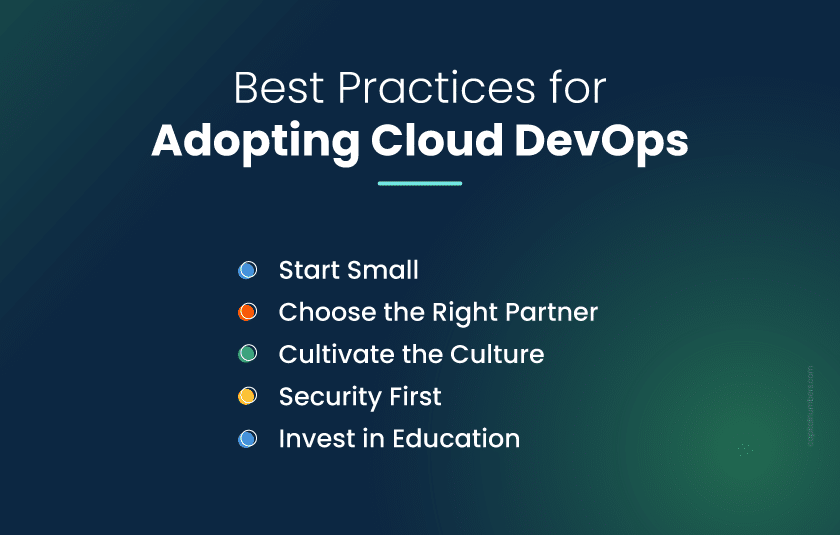
Adopting Cloud DevOps can seem difficult, especially when you’re not sure where to start. However, by following a few key principles, you can smoothly transition and maximize the benefits of Cloud DevOps. Here’s a step-by-step guide to help you get started:
Start Small
Don’t try to automate everything at once. A common mistake is diving in and attempting to automate all processes and workflows from day one. Instead, start with a single, manageable CI/CD pipeline – for example, automating the build and test process for a single application or service. This approach allows your team to get comfortable with the new tools and practices without feeling overwhelmed. Once you’ve successfully automated one pipeline, gradually scale to other parts of your infrastructure and workflows.
Choose the Right Partner
Selecting the right cloud provider is crucial to your Cloud DevOps journey. Providers like AWS, Azure, and Google Cloud offer different strengths, so it’s important to choose one that aligns with your business needs. For instance, AWS might be ideal for organizations needing vast scalability, while Azure could be more suitable for businesses already embedded in the Microsoft ecosystem. Consider factors such as your existing infrastructure, budget, and the specific DevOps tools and integrations each cloud provider offers.
Cultivate the Culture
DevOps is as much about culture as it is about technology. It’s a shift towards collaboration between development, operations, and security teams. Successful Cloud DevOps adoption requires everyone to be aligned with the same goals, from faster releases to maintaining security. Encourage shared ownership of code, infrastructure, and deployments. Break down silos and foster an environment where teams work together closely, share feedback, and continuously improve processes.
Security First
In the rush to innovate and deploy quickly, security often gets overlooked. However, security must be integrated into every step of the DevOps pipeline from day one – a practice known as DevSecOps. Automate security checks at each stage of development to catch vulnerabilities early, whether in code dependencies or cloud configurations. This proactive approach helps mitigate risks, ensures compliance, and prevent costly security breaches. Remember, security shouldn’t be an afterthought; it should be part of your culture and workflows.
Invest in Education
To use Cloud DevOps, invest in upskilling your teams. Cloud DevOps brings new tools, methodologies, and practices that may be unfamiliar to your existing development and operations teams. Offer training sessions and encourage self-learning to help your teams stay up to date with the latest technologies, from CI/CD tools to cloud-native solutions. The more knowledgeable your team is about the tools and workflows, the more successfully you’ll implement and sustain Cloud DevOps.
You May Also Read: DevOps Lifecycle: Tools, Stages, and Best Practices
Bottom Line
Cloud DevOps is a transformative approach for custom application development. By integrating automation, scalability, and security throughout the development process, businesses can build, deploy, and manage applications faster and more efficiently. Whether you’re looking to speed up development, improve software quality, or scale your app seamlessly, Cloud DevOps has the tools to make it happen. Start small, choose the right cloud provider, and foster a culture of collaboration to unlock the full potential of Cloud DevOps in your organization.
Why Choose Capital Numbers for Cloud Engineering Services?
At Capital Numbers, we specialize in building cloud solutions that are fast, scalable, and secure. Our team has extensive experience working with cloud platforms like AWS, Azure, and Google Cloud to help businesses adopt Cloud DevOps, migrate to the cloud, and optimize their infrastructure. Here’s why businesses choose us:
- Reliable Expertise: With years of experience, we’ve helped companies across industries improve efficiency and drive innovation with cloud technologies.
- Tailored Solutions: We understand that every business is unique, which is why we provide cloud strategies customized to your specific needs, whether it’s speeding up development, reducing costs, or boosting security.
- End-to-End Services: From cloud migration and automated CI/CD pipelines to container orchestration, we manage every part of your cloud journey.
- Built-in Security: We prioritize security, ensuring that your cloud applications are protected and compliant at every step of development and deployment.
Want to discuss your project? Schedule a call with us today!

